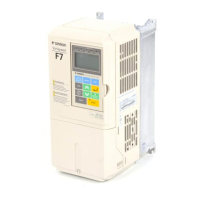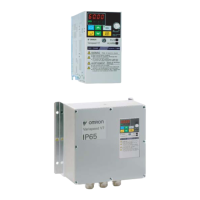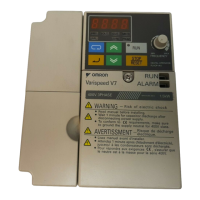6-22
Adjusting Frequency Bias Using an Analog Input
Frequency Bias (Setting: 0)
When parameter H3-09 is set to 0 (Frequency Bias), the frequency equivalent to the terminal A2 input voltage
is added to the analog master frequency input at terminal A1 as a bias.
Fig 6.24 Frequency Bias Adjustment (Terminal A2 Input)
For example, if H3-02 is 100%, H3-03 is 0%, and terminal A2 is set to 1 V, the frequency reference when 0 V
is input to A1 will be 10% of the maximum output frequency (E1-04).
Fig 6.25 Example Operation for Frequency Bias via Terminal A2
Frequency Bias 2 (Setting: D)
In contrary to the frequency bias function (H3-09=0) the frequency bias 2 function adds the analog bias value
to any master frequency value, either from the analog input, MEMOBUS communication or option boards.
The bias value is not applied to multi-step speed references using the d1- parameters.
Setting Precautions
• When the PI controller is enabled the function setting for analog input A2 is automatically switched to PI
feedback.
• If the Master Frequency Reference has to be input with a current signal (0/4 to 20 mA) the functionality of
analog input A1 and A2 can be exchanged using parameter H3-13.
• If the analog input A2 is used with a current signal ensure the proper setting of switch S1. Refer to page 2-
32, Switch S1 - Standard Terminal Board.
• In case a voltage reference signal is noisy a analog input filter time can be adjusted. By default a filter time
of 0.3 sec. is set.
Frequency bias
Multi-function analog input
terminal A2 input level
0V (4 mA/0 mA)
10 %
Bias
0 V 10 V
H3-02
Frequency reference
Terminal A1 input voltage

